DOWNLOADS
Pilgrimage places in India
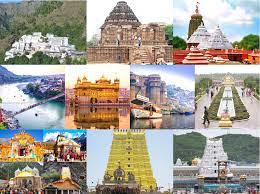 In religion and spirituality, a pilgrimage is a very long journey or search of great moral significance. Sometimes, it is a journey to a sacred area or shrine of importance to innate faith.
In religion and spirituality, a pilgrimage is a very long journey or search of great moral significance. Sometimes, it is a journey to a sacred area or shrine of importance to innate faith.
India is the largest religiously pluralistic and multiethnic democracy in the world. India is one of the most religiously and ethnically diverse nations in the world, with some of the most deeply religious societies and cultures.
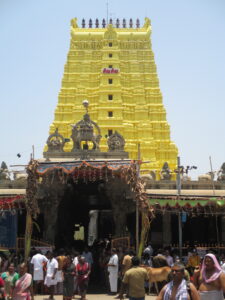 Rameswaram: also transliterated as Ramesvaram, Rameshwaram is a municipality in the Ramanathapuram district of the Indian state of Tamil Nadu. It is on Pamban Island separated from mainland India by the Pamban channel and is about 40 kilometres from Mannar Island, Sri Lanka. It is in the Gulf of Mannar, at the tip of the Indian peninsula. Pamban Island, also known as Rameswaram Island, is connected to mainland India by the Pamban Bridge.
Rameswaram: also transliterated as Ramesvaram, Rameshwaram is a municipality in the Ramanathapuram district of the Indian state of Tamil Nadu. It is on Pamban Island separated from mainland India by the Pamban channel and is about 40 kilometres from Mannar Island, Sri Lanka. It is in the Gulf of Mannar, at the tip of the Indian peninsula. Pamban Island, also known as Rameswaram Island, is connected to mainland India by the Pamban Bridge.
The story of the temple begins after the war in Lanka was over. After coming back to Rameswaram Lord Rama decided to perform the severest of austerities as a penance for the deaths in the battle and also because among those he had killed was Ravana who was a Brahmin.
Also he wanted to worship Lord Shiva to appease him as the god was angered at the death of his devotee Ravana. The Ramanathaswamy Temple is said to stand at the site of this antyeshti and prayaschitta yagya.
The Skanda Purana says the yagya took place in the month of Jyeshtha, the Tamil month of Ani; sukla paksha, dasam tithi. For the ceremony Rama needed a Shivalingam and he sent Hanuman to Mount Kailash to get a crystal lingam. However, at the auspicious hour Hanuman had still not returned and so Sita created a lingam with sand and Shiva was worshipped as Ramanatha, the lord of Rama. This is the Ramalingam that stands in the garbha griha of the temple.
Then Hanuman came back and was deeply disappointed to find the yagya over. He even tried to establish the crystal lingam in the yagya site by moving the sand lingam by wrapping his tail around it but he failed. There is even a sculpture in one temple mandapas showing this scene and the Ramanthalingam is said to carry the marks of his tail.
Rama took pity on Hanuman and said that both the lingams will be installed in the sanctum and the crystal lingam, called Vishwalingam will always be worshipped first. So, there are two shivalingams in the garbhagriha of the temple. The Vishwalingam is considered to be the jyotirlingam as it was given to Hanuman by Shiva himself. It is believed to be swayambhu, or a self manifested shivalingam. Ramanathaswamy temple is known for its imposing structure, majestic towers, intricate sculptural works and corridors, making it an architectural marvel.
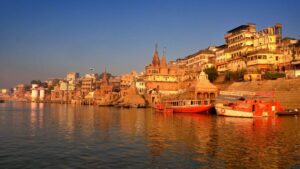 The Kashi Vishwanath Temple is a famous Hindu temple dedicated to Shiva. It is located in Vishwanath Gali, in Varanasi, Uttar Pradesh, India. The temple is one of the most sacred Hindu pilgrimage sites and is among the twelve Jyotirlinga, shrines which are said to be the most sacred abodes of Shiva. Standing on the western banks of the Ganges, the presiding deity is known by the names Shri Vishwanath and Vishweshwara (IAST: Vishveshvara or Vishveshvur), literally meaning Lord of the Universe.
The Kashi Vishwanath Temple is a famous Hindu temple dedicated to Shiva. It is located in Vishwanath Gali, in Varanasi, Uttar Pradesh, India. The temple is one of the most sacred Hindu pilgrimage sites and is among the twelve Jyotirlinga, shrines which are said to be the most sacred abodes of Shiva. Standing on the western banks of the Ganges, the presiding deity is known by the names Shri Vishwanath and Vishweshwara (IAST: Vishveshvara or Vishveshvur), literally meaning Lord of the Universe.
Varanasi was called Kashi ("shining") in ancient times, and hence the temple is popularly called Kashi Vishwanath Temple. The temple is considered a central part of worship in Shaiva culture by Hindu scriptures.
Madhuri Desai notes that accounts of the history of the temple center around a litany of repeated destruction and reconstruction.Pilgrims visiting the present Kashi Vishwanath Temple are informed about the timelessness of the lingam.The temple complex consists of a series of smaller shrines, located in a small lane called the Vishwanatha Galli, near the river. The linga of the main deity at the shrine is 60 centimetres (24 in) tall and 90 centimetres (35 in) in circumference housed in a silver altar. The main temple is quadrangle and is surrounded by shrines of other gods.
Phalgun Shukla Ekadashi is celebrated as Rangabhari Ekadashi, that is, colours. According to tradition, before Holi, Baba Vishwanath comes back to Kashi after having a cow in the form of mother Bhagwati. The temple complex is echoed by the echo of dozens of Damroos. This tradition has been performed for over 200 years. On Basant Panchami Baba's Tilak is performed, Shivaratri marriage and Rangbhari Ekadashi marks parvati leaving with shiva. These traditions are carried out by the erstwhile Mahant family of the temple for over a century.
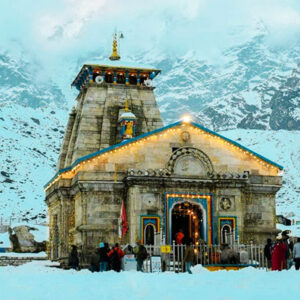 is one of the twelve Jyotirlingas of Lord Shiva. Kedarnath forms one of the four sites of the Chota Char Dham Pilgrimage.
is one of the twelve Jyotirlingas of Lord Shiva. Kedarnath forms one of the four sites of the Chota Char Dham Pilgrimage.
Dedicated to Lord Shiva, Kedarnath Temple is among the 275 temples of Paadal Petra Sthalams (the most powerful Shiva temples in the world) and is also the most important among the Panch Kedars.it is located in rudraprayag,Garhwal
The devotees experience immense peace of mind while undertaking a Kedanath temple spiritual tour. The temple and nature’s milieu is so divine that it always rekindles human beings’ faith in the Almighty. The temple has survived one of the worst flash floods in 2013 of all time in the state, hence enhancing its sacredness and the mystique in the eyes of the devotees. Devotees flock to Kedarnath pilgrimage tour site every year,as a part of Chardham Yatra circuit. Indeed, Kedarnath in Uttarakhand is one of the most prominent pilgrimages, particularly for the Hindus and spiritual seekers.
The temple and nature’s milieu is so divine that it always rekindles human beings’ faith in the Almighty. The temple has survived one of The devotees experience immense peace of mind while undertaking a Kedanath temple spiritual the worst flash floods in 2013 of all time in the state, hence enhancing its sacredness and the mystique in the eyes of the devotees. Devotees flock to Kedarnath pilgrimage tour site every year,as a part of Chardham Yatra circuit. Indeed, Kedarnath in Uttarakhand is one of the most prominent pilgrimages, particularly for the Hindus and spiritual seekers.
The Activities Around kedernath
The surroundings of Kedarnath Temple that imbibe the charm and divine aura of the shrine has spectacular attractions on offer. While sightseeing makes the most part of the activities around Kedarnath, there is a fair chance of paying homage to other sacred temples and relishing adrenaline filled trekking expeditions as well.
• A dip at Gaurikund
• Witnessing the mesmerizing Gandhi Sarovar
• Trekking to the high-altitude Vasuki Tal
• Paying respect at the Adi Shankaracharya Samadhi
• Chopper/Helicopter Ride around Kedarnath
• Visiting the sacred Triyuginarayan and Bhairav temples.
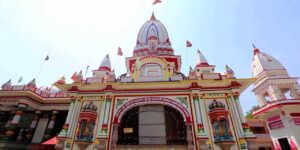 Haridwar, famous for its spiritual relevance, is one of highly visited pilgrimage places in India. Positioned on the banks of Ganges River, it portrays Indian mores and traditions in full effect. Haridwar invites folks of different beliefs and background in the beautiful state of Uttarakhand. There are a great number of holy ashrams which teach the knowledge of science, philosophy and Indian arts. It is pointless to say that the place hosts sacred fairs all throughout the year. A few of the most famous fairs are Kumbh Mela, Ganga Dusshera and Somvati Amavasya Mela. Apart from the holy importance, the city has a pleasant weather that creates a soothing impression on guests' arrivals.
Haridwar, famous for its spiritual relevance, is one of highly visited pilgrimage places in India. Positioned on the banks of Ganges River, it portrays Indian mores and traditions in full effect. Haridwar invites folks of different beliefs and background in the beautiful state of Uttarakhand. There are a great number of holy ashrams which teach the knowledge of science, philosophy and Indian arts. It is pointless to say that the place hosts sacred fairs all throughout the year. A few of the most famous fairs are Kumbh Mela, Ganga Dusshera and Somvati Amavasya Mela. Apart from the holy importance, the city has a pleasant weather that creates a soothing impression on guests' arrivals.
The holy city of Haridwar finds its recognition as Kapila, Gangadwar and Mayapuri in ancient Hindu texts of India. Each one brings to light a particular aspect of the city. It is also a gateway to the Chardham that includes the four main pilgrimages sites of Uttarakhand - Gangotri, Kedarnath, Yamunotri and Badrinath. There are oodles of tales of the sources of this heavenly place.
Of all, the most celebrated one is about the King Bhagirath, Grandson of Suryavanshi and a follower of Lord Shiva is deemed to have gotten River Ganges down from heaven by carrying out severe penance to render liberation to his ancestors. And it is also believed that the city is blessed by the existence of all three supreme gods - Brahma, Vishnu and Mahesh.
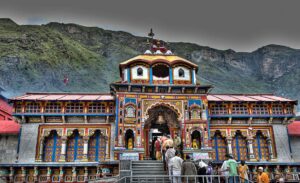 Badarinath or BadarinarayanaTemple is a Hindu temple dedicated to Vishnu. It is situated in the town of Badrinath in Uttarakhand, India.
Badarinath or BadarinarayanaTemple is a Hindu temple dedicated to Vishnu. It is situated in the town of Badrinath in Uttarakhand, India.
The badri festival is celebrated during the month of June in both the temple and the Kedarnath temple. The festival lasts for eight days; artists from all over the country perform during the function.
The major religious activities performed every morning are mahabhishek (ablution), abhisek, gitapath and bhagavat puja, while in the evening the pujas include geet govinda and arti Recital in vedic scripts like Ashtotram and sahasranama is practised during all the rituals. After aarti, the decorations are removed from the image of Badrinath and sandalwood paste is applied to it. The paste from the image is given to the devotees the next day as prasad during the nirmalaya darshan.
All the rituals are performed in front of the devotees, unlike those in some Hindu temples, where some practices are hidden from them. Sugar balls and dry leaves are the common prasad provided to the devotees. From May 2006, the practise of offering Panchamrit Prasad, prepared locally and packed in local bamboo baskets, was started.
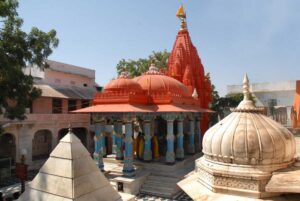 A town in renowned district of Ajmer of Rajasthan, Pushkar is known for few other religious and tourism aspects. Also, the place is supposed to have been among the oldest, while the temples standing here are not very old but built only few centuries ago, reason being the invasion of Muslim rulers.
A town in renowned district of Ajmer of Rajasthan, Pushkar is known for few other religious and tourism aspects. Also, the place is supposed to have been among the oldest, while the temples standing here are not very old but built only few centuries ago, reason being the invasion of Muslim rulers.
Brahma temple: The temple located near the Pushkar Lake, is most revered temples located in the town and holiest of all the Brahma Temple around the world. A huge idol of the creator of the universe inspired worship in mere mortals easily.
Pushkar Lake: The Lake originating from Luni River, has 52 bathing banks to facilitate huge crowds during the occasion of 'Kartik Poornima' in the month of October-November, all of them being dotted with numerous temples dedicated to various Gods and Goddesses in Hindu religion. Sacred to Hindu as well as Sikh rulers, this lake has its mention in history since 4th century.
Varaha Temple: Being upset on huge idol of Lord Varaha (head of a boar and body of a man), the original temple of 12th century was destroyed by Mughal Emperor Aurangzeb. It was then rebuilt in 18th century by Raja Sawai Man Singh II.
Pushkar Camel Fair: The festival is 'apple of eyes' of Rajasthan Tourism Department when it comes to the contribution of Pushkar to tourism. Held during the time of Kartik Poornima, the festival is also recorded as the 'World's Largest Cattle Fair'. The northern states get engage in huge cattle trade, while the locals and wandering tribes take the opportunity to paint the festival with excitement of rituals and games, which consequently interests foreign tourists.
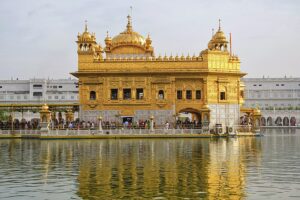 The Golden temple is famous for its full golden dome, it is one of the most sacred pilgrim spots for Sikhs. The Mandir is built on a 67-ft square of marble and is a two storied structure. Maharaja Ranjit Singh had the upper half of the building built with approximately 400 kg of gold leaf. The Golden Temple is surrounded by a number of other famous temples like the Durgiana Temple. The fourth Guru of Sikhs, Guru Ram Das, who had initially constructed a pool here, founded Amritsar, which houses the Golden Temple or Harmandir Sahib. It is here that Sage Valmiki wrote the epic, Ramayana. Rama and Sita are believed to have spent their fourteen-year exile in Amritsar, the epicenter of Sikhism.
The Golden temple is famous for its full golden dome, it is one of the most sacred pilgrim spots for Sikhs. The Mandir is built on a 67-ft square of marble and is a two storied structure. Maharaja Ranjit Singh had the upper half of the building built with approximately 400 kg of gold leaf. The Golden Temple is surrounded by a number of other famous temples like the Durgiana Temple. The fourth Guru of Sikhs, Guru Ram Das, who had initially constructed a pool here, founded Amritsar, which houses the Golden Temple or Harmandir Sahib. It is here that Sage Valmiki wrote the epic, Ramayana. Rama and Sita are believed to have spent their fourteen-year exile in Amritsar, the epicenter of Sikhism.
To the south of the temple is a garden, and the tower of Baba Atal. The Central Sikh Museum is atop the Clock Tower. The ‘Guru Ka Langar’ offers free food to around 20,000 people everyday. The number shoots up to 100,000 on special occasions. A visitor must cover his / her head before entering the temple premises. The Granth Sahib is kept in the Temple during the day and is kept in the Akal Takht or Eternal Throne in the night. The Akal Takht also houses the ancient weapons used by the Sikh warriors. Guru Hargobind established it. The rugged old Jubi Tree in the north west corner of the compound is believed to possess special powers. It was planted 450 years ago, by the Golden Temple’s first high priest, Baba Buddha.
Guru-ka-Langar or the communal canteen is towards the eastern entrance of the temple complex, and it provides free food to all visitors, regardless of colour, creed, caste or gender. Visitors to the Golden Temple must remove their shoes and cover their heads before entering the temple. The temple is less crowded in the early mornings on weekends.
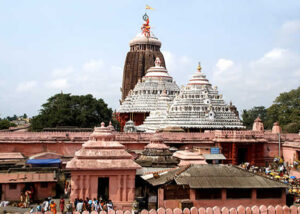 The Jagannath temple is located in Puri in the state of Orissa and is one of the char dham after Badrinath, Rameshwaram, and Dwarka. So it is of great importance to the Hindus who believe Lord Jagannath is one of the incarnations of Lord Vishnu. Every day thousands of devotees visit the temple which is regarded as the most important pilgrimage to visit at least once in one’s life. The temple is very large as been built by King Ananga Bhima Deva. Due to its great significance, only Hindus are allowed to enter the temple. There are 3 deities on the throne of the temple – Jagannath who is regarded as the king of the world, his brother Balabhadra and their sister Suvadra.
The Jagannath temple is located in Puri in the state of Orissa and is one of the char dham after Badrinath, Rameshwaram, and Dwarka. So it is of great importance to the Hindus who believe Lord Jagannath is one of the incarnations of Lord Vishnu. Every day thousands of devotees visit the temple which is regarded as the most important pilgrimage to visit at least once in one’s life. The temple is very large as been built by King Ananga Bhima Deva. Due to its great significance, only Hindus are allowed to enter the temple. There are 3 deities on the throne of the temple – Jagannath who is regarded as the king of the world, his brother Balabhadra and their sister Suvadra.
Every year the annual Rath Yatra is celebrated and a huge number of people are seen gathering on the highway. Rath yatra means the journey of the chariot. Three chariots are designed and decorated beautifully for the three Hindu deities and after traveling a certain distance they reach their masir bari or aunt’s house and again return from there after seven days along the same route. Thousands and thousands of devotees and travelers gather on the day of Ratha yatra which is held in the month of June every year. Other than a pilgrimage visit it is also believed that if couples visit the temple after marriage and start their journey of life after taking the blessing of Lord Jagannath then their life is fulfilled.
The Jagannath Temple is a famous Hindu temple located in Puri, Odisha, India. It is dedicated to Lord Jagannath, an incarnation of Lord Vishnu. The temple is one of the Char Dham pilgrimage sites for Hindus and one of the most sacred places for Vaishnavism. It is believed to have been built in the 12th century by King Anantavarman Chodaganga Deva and is considered a masterpiece of Kalinga architecture. The temple’s most notable feature is its towering “Neo-Kalinga” style architectural structure, which is around 215 feet tall. The temple complex also includes several other smaller shrines and is surrounded by a massive wall with a compound, called the Meghanad Pacheri. The temple’s annual Rath Yatra festival is attended by millions of devotees from around the world.
The second-most visited Hindu pilgrimage destination in India, Mata Vaishno Devi Cave Temple is situated in the Trikuta Hills in Katra, Jammu & Kashmir. Hindu devotees from all over the world visit this famed religious site where the Mother Goddess or Mata Vaishno Devi is said to fulfill their wishes. This religious place is considered the most important Shaktipeeth as it is believed, here the skull of the Goddess Sati fell.
At Mata Vaishno Devi Cave, the goddess is in the form of a five and a half feet tall rock which has three heads or the Pindies. On Mata Vaishno Devi pilgrimage, devotees make traditional offerings to Mata of chunri (a red coloured drape), sarees, dry fruits, silver or gold ornaments, cholas, flowers etc.
Mata Vaishno Devi Shrine Board was formed in 1986 and ever since this most popular religious site in Jammu started to attract a lot of Hindu pilgrims.
The holy cave of Mata Vaishno Devi is said to have been discovered by Pandit Sridhar, a Hindu priest.
Goddess Vaishnavi appeared in the dream of the priest and instructed him on how to find here abode on Trikuta Hills. The priest following her instruction heads out for the journey after the dream and found the cave as instructed earlier. Mata Vaishno Devi appeared to him and blessed him with four sons. She also gave him the boon of being the custodian of the cave. Even today, Pandit Shridhar’s descendant abide by the commitment.
• A trek of 13 km takes one to Mata Vaishno Devi, however for those who are unable to walk, ponies are also available.
• A ropeway is constructed between Mata Vaishno Devi Cave and Bhairon Ghati.
• Alcohol is strictly ban in Katra and vegetarian food is available in the town.
• Cameras are not allowed on the trek, thus, one should leave them in their hotels.
• A yatra slip has to be obtained from Yatra Registration Counter near Bus Station in Katra. One is not allowed to visit Mata Vaishno Devi without the yatra slip.
• Confirm the rates of porters, palanquin, and ponies before hiring them.
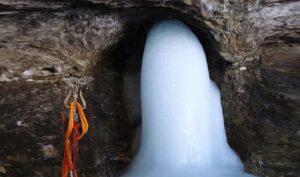 Amarnath Yatra is among the most revered pilgrimage circuits among Hindus. This annual event starts in July and goes on till mid-August every year. This holy Yatra lasts for around 45 days and is undertaken by thousands of people from all over the country.The Amarnath Cave was discovered by a Muslim shepherd Buta Malik in 1850. According to the lore, he was roaming with his herds in the mountains, and a saint met him there.
Amarnath Yatra is among the most revered pilgrimage circuits among Hindus. This annual event starts in July and goes on till mid-August every year. This holy Yatra lasts for around 45 days and is undertaken by thousands of people from all over the country.The Amarnath Cave was discovered by a Muslim shepherd Buta Malik in 1850. According to the lore, he was roaming with his herds in the mountains, and a saint met him there.
The saint gave him a bag full of coal, and when he reached home, he opened the bag, and he found a bag full of gold instead of coal. He was overjoyed and ran back to the same place to thank the saint, but he did not find the saint. Instead, he found the cave and the ice Lingam.He informed the villagers about this and shared this story, after which the pilgrimage to Amarnath Cave started.
According to myths, the Kashmir Valley was submerged underwater, and Sage Kashyap drained it through a series of rivers and creeks. After this incident, Rishi Bhrigu was the first to have discovered Amarnath.He has had a darshan of Lord Shiva at Amarnath, and after listening to this story, people started to undertake the pilgrimage circuit to Amarnath Cave, which takes place in July and August.
There are numerous legends related to the Amarnath Cave. Among them, there is a most famous legend, which depicts that Lord Shiva has chosen this place to share the secret of immortality and the process of formation of the universe with Goddess Parvati.He shared the story with Goddess Parvati about why he wears a bead of heads and what it implies. He told her that the head in the bead increases every time she is reborn. To this, Goddess Parvati asked about the reason behind Lord Shiva’s immortality.He told her that she demanded to hear Amar Katha, which is a difficult task to listen for a human in one go and without sleeping.
